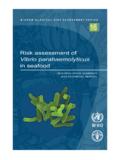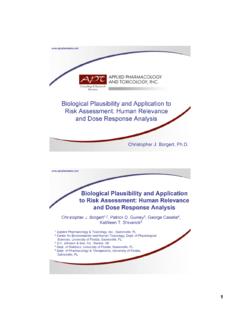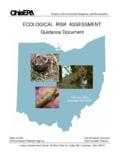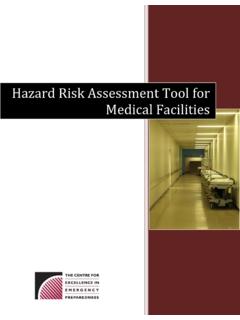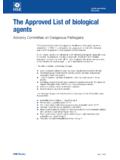Transcription of Risk Assessment Training-FoE - Department of Biomedical ...
1 RISK Assessment APPLICATION TRAININGBy Faculty of Engineering, Safety Assessment Overview Group Activity Identification Group Activity Control Measures Group Activity & ReviewWhat is Risk Assessment ?Risk Assessment is a systematic approach to identify hazards, evaluate risk and incorporate appropriate measures to manage and mitigate risk for any work process or Assessment is not a product of perception or experience but an evaluation base on is Risk Assessment ?Definition for some Basic WordsSafety Freedom from harmHazard Potential to cause harm such as death, injury, ill health or damage to property Risk Likelihood of the hazard resulting in harm and the severity of the effects from the hazard. Risk = Severity x Probability (likelihood of Occurrence)Why Risk Assessment ?
2 Key to Prevention of Accidents and Adverse ConsequencesAssurance on a Safe WorkplaceLegal Compliance - Workplace Safety & Health Act- Those who creates risk will need to manage the risk- Implementation of Risk AssessmentAccidents do happen, even in role is to manage the risk and incorporate adequate measures to prevent it. Risk ConceptsRISKA cceptability CriteriaHow Serious??ConsequencesHow Often??LikelihoodWhat can go WrongHow likely is it?What are the ImpactsUnderstand RiskMANAGE RISKRisk ConceptsLegal RequirementLegal RequirementWorkplace Safety & Health ActEffective from 1stMarch WSH Act is an essential part of the new OSH framework to cultivate good safety habits in all individuals at the requires every person at the workplace to take reasonable practicable steps to ensure the safety and health of every workplace and RequirementReasonable PracticableAction is considered to be practicable when it is capable of being RequirementReasonable PracticableReasonable usually takes into account: The severityof harm & degree of risk (or likelihood) of that injury or harm occurring.
3 Greater risk, reasonable to go to very considerable expense & effort to reduce it How much is knownabout the hazard & the ways of eliminating, reducing or controlling it. What are others practicing & what the standards recommend? The availability, suitability and cost of the safeguards. Costof safeguards to measure against consequence of failure to do RequirementWorkplace Safety And Health (Risk Management) Regulations 2006 Enforced from 1stSeptember WSH (Risk Management) Regulations require employers, the self-employed and principal (including contractor and sub-contractor) to conduct risk assessments for the purpose of identifying workplace safety and health risks and implementing measures to control the hazards and reducing the generates the risk shall manage the RequirementWorkplace Safety And Health (Risk Management) Regulations 2006 PenaltiesAny person who fails to comply may be fined up to $10,000 for the first offence.
4 For a second or subsequent offence, the person may be fined up to $20,000 or jailed up to 6 months or 3(1)R 3(1)--Conduct Risk AssessmentConduct Risk AssessmentR 4(1)R 4(1)--Eliminate, Minimise & Control Risk, Specify ResponsibilitiesEliminate, Minimise & Control Risk, Specify ResponsibilitiesR 5R 5--Maintain Risk Assessment RecordMaintain Risk Assessment RecordR 6R 6--Inform Those At Risk of risks & Measures, SWPI nform Those At Risk of risks & Measures, SWPR 7R 7--Review of Risk of Risk Identify Workplace Potential hazards2. Evaluate Workplace Risks3. Propose control measures to mitigate risks4. Submit Assessment report to Management/PI for implementation of control measures5. Submit a copy of completed RA to Safety Officer for recordRisk AssessorRoles & Responsibilities1.
5 Resource provider2. Owner of process/experiment3. Ensure risk Assessment has been conducted for all work activity & experiment under him/her4. Endorse & implement control measures to mitigate risk5. Communication of hazards & controls to affected parties6. Ensure all risk Assessment has been timely reviewed and a record of all risk Assessment have been & ManagementRoles & ResponsibilitiesRisk Management OverviewComponents of Risk Mgt1. Information Preparation2. Hazard Identification3. Risk Evaluation4. Risk Control5. 6. Implementation & reviewRisk AssessmentRecord keepingRisk Management Process Overview1. Preparation1. Preparation2. Hazard Identification2. Hazard Identification3. Risk Evaluation3. Risk Evaluation4. Risk Control4. Risk Control5.
6 Record Keeping5. Record Keeping6. Implementation & Review6. Implementation & ReviewAll information necessary for risk Assessment should be obtained as far as workplace hazards associated with each work activity or trade, and potential accidents or incidents. Estimate the risk levels of the workplace hazards identified. Prioritise measures to control the hazards and minimise the safety and health risksControl hazards and reduce risks by following the Hierarchy of Control measures: Elimination Substitution Engineering Controls Administrative Controls Personal Protective Equip. Keep the written description of the risk Assessment for at least 3 years. All risk Assessment records should be concise and kept in a Assessment plans should be reviewed: Once every 3 years (making reference to the previous risk Assessment .)
7 Whenever new information on safety and health risks surfaces. There are changes to the area of work and / or After any accident or serious Information needed for risk Assessment - Material Safety Data Sheets- Chemical inventory- Photos, drawings, design, operation manual- Process flow charts- Accident records- Relevant Legislation & CPs2. List of work activities / process3. Sequence of work activity / processInformation PreparationHow to do a risk Assessment ? & prioritise lab activity/teaching Use, handling, storage and disposal of the the hazards of each activity / procedure the potential adverse effects (Consequence) current/existing the Severity (S) and Likelihood (L) of accidents/incidents arising from these the risk rating by multiplying S & risk is unacceptable, incorporate additional control measures to bring risk to Assessment TemplateActivity or Experiment-Based Risk Assessment FormDepartment:Name of Experiment/Activity:Location:Name of Person in-charge:Name of PI:Last Review Date:Next Review Date:1.
8 Hazard Identification2. Risk Evaluation & ControlSNTaskHazardsPossible ConsequencesExisting Risk Control(if any)SLRA dditional / New Risk ControlSLRA ction ByDeadlineConducted by: (Name, designation)Approved by: (Name, designation)Signature:Signature:Date:Dat e:Risk Assessment SampleActivity or Experiment-Based Risk Assessment FormDepartment:Chemical DeptName of Experiment/Activity:Use of hot-plateLocation:E5-06-07 Name of Person in-charge:Ivy OngName of PI:Prof Lim See InLast Review Date:Next Review Date:19 Feb 20101. Hazard Identification2. Risk Evaluation & ControlSNTaskHazardsPossible ConsequencesExisting Risk Control(if any)SLRA dditional / New Risk ControlSLRA ction ByDeadline01 Place Sample on hot plateGlass beakerBreakage causing cutsGloves122 ElectricityElectrical shorts/fireDistance313 Toxic sampleToxic effectsFumehood31302 Turn on hot plateOver tempGlass breakageSigns & SOP 224 Regular monitoring212 Ivy Ong21 Feb 08 Reactive sampleExplosionSupervision326 Utilise water bath313 Ivy Ong21 Feb 08 Conducted by: (Name, designation)Ivy Ong, Kee Wah & David NgApproved by: (Name, designation)Prof Lim See In (Project Supervisor)Signature:Signature:Date:20 Feb 2008 Date.
9 21 Feb 2008 Ultimately all tasks in laboratory Jobs does not have a written procedure First jobs with highest rates of accidents or greatest potential for injuries New Experiments Changes in process and proceduresInvolve all students and researchersPrioritise Activity/Experiments Practical constraints on time and resources Some experiments are more hazardous than others and some have worse incident history than others Factors that can be considered to prioritize Frequency of past incidents Severity of potential activities Infrequently performed jobs: students may be greater risk when undertaking non-routine tasks Prioritise Activity/ExperimentsA task is a single, separate, specific component of the employee s overall Activity Experiment into TasksA TASKis a singleactivity that clearlyadvances a work assignment and isa logical portion of that assignment.
10 Task is a segment of an overall job Completion of each operational task in proper sequence leads to the completion of the job Break down into basic steps or task- Important to keep the tasks in their correct sequence Dividing a job into tasks requires a thorough knowledge of the jobBreak down into Successive TasksIf the tasks are made too general, specific operations and related hazards may be missedToo many tasks may make the Risk Assessment impracticalRule of Thumb:- Most experiments can be described in less than ten tasks normally 6 8 into a team of 3-4 down the lab activities and prioritise the activity by estimating their risk level and rank them in order of most hazardous to the least hazardous using PI, P2 & one top priority activity/experiment and break down into successive representative to present and use flip chart for the Practical ActivityActivity 1: Listing & Prioritise of Lab Activity/Teaching Experiment (10 mins)Lab Activity/eaching ExperimentPriority List (P1/P2/P3)Hazards Identification The most important step precedingany Risk Assessment - hazards can only be controlledifthey are identified.

